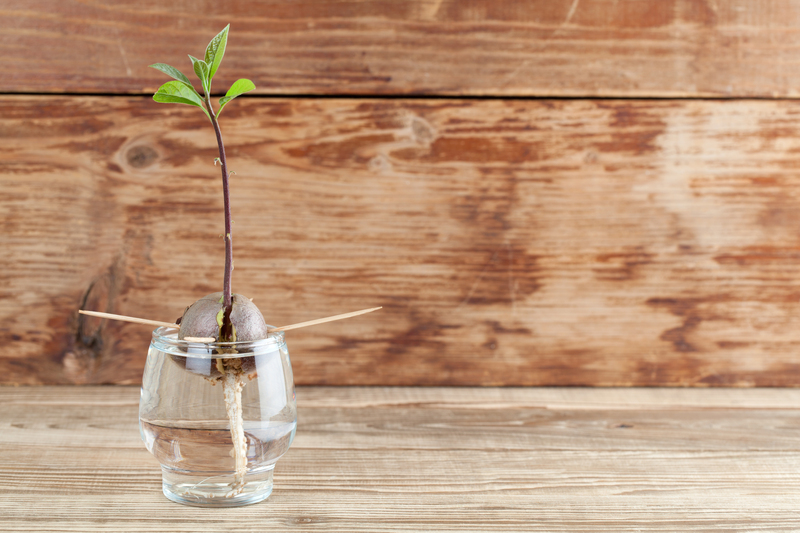Discover the secrets of planting a thriving herb garden
Posted on 21/09/2025
Discover the Secrets of Planting a Thriving Herb Garden
There's something magical about stepping out into your backyard, balcony, or windowsill and snipping fresh herbs to enhance your culinary creations. Are you ready to unlock the secrets and learn how to plant a thriving herb garden of your own? If so, this guide will provide you with all the information and inspiration needed to grow lush, flavorful, and productive herbs, whether you are a beginner or a seasoned gardener.

Why Plant a Herb Garden? Amazing Benefits Revealed
- Freshness at Your Fingertips: Enjoy vibrant flavors and aromas that dried or store-bought herbs simply can't match.
- Cost-Effective: Growing herbs helps you save money over buying packaged bunches that often wilt before you can use them entirely.
- Health Benefits: Many herbs have medicinal properties and are rich in antioxidants and essential vitamins.
- Aesthetic Appeal: A thriving herb garden introduces beauty, fragrance, and greenery to any space.
- Pollinator Attraction: Flowering herbs draw bees, butterflies, and beneficial insects to your garden.
The Foundation: Choosing the Right Location for Your Herb Garden
Planting a successful herb garden starts with selecting the ideal location. Most herbs adore sunlight! Aim for at least six to eight hours of direct sunlight each day. South- or west-facing windowsills are perfect for indoor gardens, while a sunny corner of your yard or a bright balcony suits outdoor plots.
Top Tips for Site Selection:
- Check for Drainage: Well-drained soil is crucial - soggy roots spell disaster for most herbs.
- Accessibility: Plant your herb garden close to the kitchen for easy harvesting.
- Protection from Wind: Herbs appreciate shelter from harsh winds, which can dry them out quickly.
The Best Herbs for a Flourishing Garden: Top Picks for Beginners and Experts
When it comes to planting a thriving herb garden, variety is key. Not all herbs have the same requirements or growth habits. Consider your climate, sunlight, and cooking preferences when selecting your plants.
Perennial Herbs
- Rosemary: Woody, aromatic, and perfect for Mediterranean dishes.
- Mint: Vigorous, spreading, and best grown in its own container.
- Chives: Delicate onion flavor, beautiful purple blossoms (edible too!).
- Oregano: Robust, great for Italian and Greek cuisine.
- Thyme: Low-growing, drought-tolerant, lovely floral notes.
Annual and Biennial Herbs
- Basil: Sun-loving, essential for pesto and salads.
- Cilantro: Fast-growing, key for salsas and curries.
- Parsley: Flat or curly-leafed, versatile in many dishes.
- Dill: Great for pickling and fish dishes.
- Chamomile: Delicate apple scent, soothing for teas.
Pro Tip: Mix annuals and perennials for season-long harvests and enduring beauty!
Grow in the Ground, Pots, or Indoors?
There are several ways to create a successful herb garden:
- In-Ground Planting: Ideal for those with outdoor garden space. Herbs can grow large and lush.
- Raised Beds: Improved soil drainage and easier maintenance.
- Container Gardening: Perfect for balconies, patios, and controlling aggressive spreaders like mint.
- Indoor Herb Gardens: Great for year-round access, even in colder climates.
Soil Secrets: Preparing for a Lush Herb Garden
A thriving herb garden begins with healthy, nutrient-rich soil. Most culinary herbs prefer soil that is well-aerated, slightly alkaline to neutral (pH 6.0 to 7.5), and rich in organic matter.
Steps to Prepare the Best Herb Garden Soil:
- Test Your Soil: Purchase an inexpensive pH test kit and adjust as needed. Add lime to raise pH or peat moss to decrease it.
- Improve Drainage: Mix in coarse sand or fine gravel for heavy soils.
- Enrich with Compost: Well-rotted compost provides essential nutrients without overwhelming herbs with nitrogen.
- Use Mulch: Mulching conserves moisture and suppresses weeds. Organic mulch like straw or chopped leaves works beautifully.
Seeds or Seedlings? How to Start Your Thriving Herb Garden
There's more than one way to launch your herb garden:
- Sow Seeds: Gives you the widest selection and is budget-friendly. Start indoors 6-8 weeks before the last frost, or sow directly outdoors after danger of frost has passed.
- Buy Seedlings: Offers instant gratification and is ideal for beginners.
- Propagate from Cuttings: Some herbs, like mint, thyme, and basil, root easily in water.
Carefully read each plant's seed packet or plant tag. Depth and spacing matter! Overcrowding is a common mistake when planting a new herb garden, which can lead to poor air circulation and disease.
Essential Care Tips: How to Cultivate Healthy, Happy Herbs
1. Watering Wisdom
- Herbs dislike wet feet. Water deeply, but let soil dry slightly between waterings.
- Morning waterings help prevent fungal diseases and root rot.
2. Feeding Your Herbs
- Fertilize sparingly. Too much fertilizer promotes leaf growth but can decrease flavor.
- Organic compost or fish emulsion applied every few weeks during peak growth is usually sufficient.
3. Pruning and Harvesting
- Frequent harvesting is the secret to bushy, productive plants. Pinch back stems just above a set of leaves to encourage branching.
- Avoid letting annual herbs like basil and cilantro flower or seed, as this signals the plant to stop producing leaves.
4. Pest and Disease Management
- Practice companion planting to deter pests naturally (e.g., basil repels flies and mosquitoes).
- Inspect leaves regularly for signs of aphids or mildew and treat promptly with insecticidal soap if needed.
- Healthy, well-spaced plants are less susceptible to most issues.
Design Secrets: Plan a Stunning and Productive Herb Garden
Creating a beautiful herb garden that thrives isn't just about planting randomly--it's about thoughtful planning!
Design Tips:
- Group by Water Needs: Put drought-tolerant Mediterranean herbs (like rosemary, thyme, and oregano) together, and moisture lovers (like basil and parsley) in a separate spot.
- Vary Heights and Colors: Use tall herbs like dill or fennel as a backdrop with sprawling ground covers in front.
- Pathways for Access: Design narrow beds or containers so you can easily reach and harvest every plant.
- Incorporate Structure: Create spirals or raised beds for a dramatic visual effect and improved drainage.
- Interplant with Flowers: Nasturtiums or calendula add color and attract beneficial insects, while marigolds naturally repel pests.
Harvesting and Preserving: The Ultimate Joy of a Successful Herb Garden
The real payoff for planting a thriving herb garden comes when you harvest and preserve your bounty. Here's how to make the most of your homegrown herbs:
How to Harvest Herbs Successfully
- Harvest in the morning after the dew dries but before the day heats up, when essential oils are most concentrated.
- Use sharp, clean scissors or pruners to snip stems just above a pair of leaves.
- Never harvest more than a third of the plant at once; this ensures continued growth and vigor.
Preserving Your Herb Harvest
- Drying: Bundle herbs in small bunches and hang upside down in a cool, airy place.
- Freezing: Chop herbs and freeze in olive oil or water in ice cube trays for easy use in stews and sauces.
- Infusing: Make herb-infused oils, vinegars, or butters for a burst of flavor year-round.
Troubleshooting: Common Herb Garden Challenges & Solutions
Brown, Wilted Leaves?
- Often a sign of overwatering or poor drainage. Allow soil to dry out a bit and consider adding sand to improve drainage.
Leggy Growth?
- Not enough light. Move your herbs to a sunnier spot or supplement with grow lights indoors.
Pale, Chewed Foliage?
- Check for pests like aphids, caterpillars, or slugs. Use gentle, organic pest control methods whenever possible.
No matter the issue, attentive care and observation are the keys to success.
Special Tips for Indoor Herb Gardens
- Use a high-quality potting mix appropriate for containers; garden soil is usually too heavy.
- Ensure pots have drainage holes to prevent root rot.
- Rotate pots regularly to ensure even exposure to sunlight and prevent plants from leaning.
- Supplement with LED grow lights in winter or shady rooms for lush, continuous growth.

Unlock the True Potential of Your Herb Garden: Final Secrets for Success
- The most important ingredient is enthusiasm! Don't be afraid to experiment with new varieties and flavors.
- Companion planting with vegetables and flowers magnifies your garden's vitality and aesthetics.
- Keep a garden journal to track planting dates, successes, and lessons for each season.
- Share your harvest--nothing spreads the joy of gardening like giving friends and neighbors a fresh bundle of basil or mint!
Planting a thriving herb garden is more than just a hobby--it's a lifestyle. With these expert secrets, you'll enjoy year-round harvests, healthier meals, and a vibrant, fragrant oasis at home.
Start Your Thriving Herb Garden Today!
Now you know the secrets of planting and maintaining a flourishing herb garden. Gather your seeds, prep your soil, and celebrate every new green sprout--your journey to fresh flavor and garden success begins today!
Have questions or your own herb gardening secrets? Share your tips in the comments below and help others grow their own culinary paradise!



